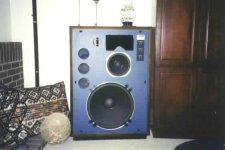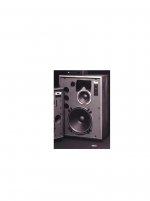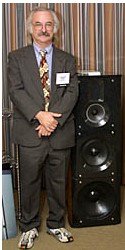In the course of tuning my vintage JBL 4345 monitor project I got some recent friendly assistance from JBL legend Greg Timbers.
I'm a member of the Lansing heritage Forum and have been slowly piecing together all the original parts for the classic 4345 (4) way monitor.
One of the biggest hurdles was determining the box tuning of the original design. I tried to calculate it based on T/L tables and software simulations but could not get the woofer system to sound right and integrate correctly with the mid and high end.
The catalogued specs refer to a 9 cubic foot box, ported by 3 circular openings with full power to 32hertz. No reference is give to the box tuning and after attempting calculation of the Fb from the T/L tables from the driver QTS it became clear that there were just too many unknowns for me to replicate the response of the original design.
I had the volume right, with 3 4" ports about 8.5 inches long for an educated Fb of 28 hertz, 1 inch of fibre glass on 3 internal surfaces, but it sounded strange, sort of underdamped.
Anyway I quickly emailed JBLPro.com requesting details of the 4345 tuning, choke DCR (this effects the system QTS ), box losses etc so I could hit the target tuning.
Within a day I received a very comprehensive account of the system tuning from Greg Timbers, the original design engineer for all the JBL 43xx series monitors.
I made two incorrect assumptions, firstly I did not account for the virtual volume introduced by the fibreglass damping. The effect of this is the fibre glass lining adds volume equivelant to the bacing and the backside of the woofer, about 1.5 - 2.00 cu ft. This means the woofer is really looking into about 10.5 cu ft, a 15 % increase in the dimensioned box size of 9 cu feet. As a consequence my calculations were out of wack.
Secondly, the dcr of the choke in the original design was 0.5 ohms. My choke was 0.2 ohms. apparently JBL could not afford low dcr in these large chokes (5.4 mh) in production. The effect on the QTS of the driver (0.27) is to raise the total system QTS to near 0.292.
The only alteration I had to make was adding a 0.3 ohm resisters in series with my choke in the woofer low pass network.
The result is magic, the bass is brilliant, accurate , extended and effortless from thr 18" JBL 2245 driver.
Here is a mint example of the design I am aiming for, this particular pair is actually up for sale on the Lansing Heritage classifieds if any one is interested.
Ian
I'm a member of the Lansing heritage Forum and have been slowly piecing together all the original parts for the classic 4345 (4) way monitor.
One of the biggest hurdles was determining the box tuning of the original design. I tried to calculate it based on T/L tables and software simulations but could not get the woofer system to sound right and integrate correctly with the mid and high end.
The catalogued specs refer to a 9 cubic foot box, ported by 3 circular openings with full power to 32hertz. No reference is give to the box tuning and after attempting calculation of the Fb from the T/L tables from the driver QTS it became clear that there were just too many unknowns for me to replicate the response of the original design.
I had the volume right, with 3 4" ports about 8.5 inches long for an educated Fb of 28 hertz, 1 inch of fibre glass on 3 internal surfaces, but it sounded strange, sort of underdamped.
Anyway I quickly emailed JBLPro.com requesting details of the 4345 tuning, choke DCR (this effects the system QTS ), box losses etc so I could hit the target tuning.
Within a day I received a very comprehensive account of the system tuning from Greg Timbers, the original design engineer for all the JBL 43xx series monitors.
I made two incorrect assumptions, firstly I did not account for the virtual volume introduced by the fibreglass damping. The effect of this is the fibre glass lining adds volume equivelant to the bacing and the backside of the woofer, about 1.5 - 2.00 cu ft. This means the woofer is really looking into about 10.5 cu ft, a 15 % increase in the dimensioned box size of 9 cu feet. As a consequence my calculations were out of wack.
Secondly, the dcr of the choke in the original design was 0.5 ohms. My choke was 0.2 ohms. apparently JBL could not afford low dcr in these large chokes (5.4 mh) in production. The effect on the QTS of the driver (0.27) is to raise the total system QTS to near 0.292.
The only alteration I had to make was adding a 0.3 ohm resisters in series with my choke in the woofer low pass network.
The result is magic, the bass is brilliant, accurate , extended and effortless from thr 18" JBL 2245 driver.
Here is a mint example of the design I am aiming for, this particular pair is actually up for sale on the Lansing Heritage classifieds if any one is interested.
Ian
Attachments
macka,
How did you determine the cubic feet increase due to the fiberglass?
Will this increase determine the amount of walls that are
damped (Sides, back, top, bottom)?
And, lastly. How did you calculate the numbers?
I know JBL are notorious for not skimping on fiberglass
in their enclosures, in which I follow the same rule in
all my designs.
I would really like to find out how would one calculate
the fiberglass in the box to determine the total internal
volume of the chamber.
How did you determine the cubic feet increase due to the fiberglass?
Will this increase determine the amount of walls that are
damped (Sides, back, top, bottom)?
And, lastly. How did you calculate the numbers?
I know JBL are notorious for not skimping on fiberglass
in their enclosures, in which I follow the same rule in
all my designs.
I would really like to find out how would one calculate
the fiberglass in the box to determine the total internal
volume of the chamber.
Glass Dust In The Air.
Fibreglass damping and vented encloseures have never been a good idea.
Eric.
Fibreglass damping and vented encloseures have never been a good idea.
Eric.
Okay,
How did you determine the cubic feet increase due to the fiberglass?
They did the tuning largely on imperical basis. ie they got the tuning in a ball park, then fine tuned the system based on listening trials.
That said the JBL Software (BassBox 5.1) advises 1" fibre glass on 5 side (excpet front baffle) gives a 10=15 % increase.
The effect on fibre glass is really called QL in speaker engineering
Minimal Fill = 5%= 2 sides
Normal Fill = 10%= 5 sides
Heavy Fill = 50% = all sides 5 cm fiibre glass
Normally in vented designs you use only damping on the walls to stop mid range honk, not to damp the system, however you must allow for volume effects.
In this case I new the static volume and the total box size.
The tricky part is calculating the vent length to account for the virtual volume, I used the software for that, its quite accurate.
The numbers are a mine field, suggest you search for Box plot and down load its easier than farting around with T/L tables.
Robert Bullock title Bullock on Boxes is a also a good read.
Ian
How did you determine the cubic feet increase due to the fiberglass?
They did the tuning largely on imperical basis. ie they got the tuning in a ball park, then fine tuned the system based on listening trials.
That said the JBL Software (BassBox 5.1) advises 1" fibre glass on 5 side (excpet front baffle) gives a 10=15 % increase.
The effect on fibre glass is really called QL in speaker engineering
Minimal Fill = 5%= 2 sides
Normal Fill = 10%= 5 sides
Heavy Fill = 50% = all sides 5 cm fiibre glass
Normally in vented designs you use only damping on the walls to stop mid range honk, not to damp the system, however you must allow for volume effects.
In this case I new the static volume and the total box size.
The tricky part is calculating the vent length to account for the virtual volume, I used the software for that, its quite accurate.
The numbers are a mine field, suggest you search for Box plot and down load its easier than farting around with T/L tables.
Robert Bullock title Bullock on Boxes is a also a good read.
Ian
Hi Ian,
Now I see what you wanted the 2405's for.
What are you using for the mid-horn and driver? Where are you crossing over?
15% is what I've always used. It will usually workout close enough to do the final tuning with the the port length. You're never going to hear 1 or 2Hz difference in the f3. As long as the overall Q is about where you want it to be, it should perform as predicted
I think Eric is concerned about silicosis from breathing in the glass fibers.
Hey Eric, just get one of those SARS masks.
Rodd Yamashita
Now I see what you wanted the 2405's for.
What are you using for the mid-horn and driver? Where are you crossing over?
15% is what I've always used. It will usually workout close enough to do the final tuning with the the port length. You're never going to hear 1 or 2Hz difference in the f3. As long as the overall Q is about where you want it to be, it should perform as predicted
I think Eric is concerned about silicosis from breathing in the glass fibers.
Hey Eric, just get one of those SARS masks.
Rodd Yamashita
Rodd,
Correct, The mid horn is a JBL 2420 the Ti bottle top, the horn the 2307 and 2308 slant lense as per the original 4345.
The crossover is 1.30 Khz and 9.0 khz, the slopes are customised 18 db high pass and 12 db low pass.
Your are right about the Q, this was however my unknown and my guess was 10% less than the QTS JBL reaslised with the added drc of their choke, so I was trying to match the wrong Q with their Box size causing a misalignment.
Fortunately JBL took this into consideration with the tuning and at least on a subjective basis it sounds very good if not excellent tuning..."just right".
The trick for all reading this is to base the box volume on the total QTS (incl crossover dcr, cables etc), this will then give the correct Alpha ~ value for Vas/Alpha = Box volume and Fb = Fs x H,
If in doubt add 10 % to your driver QTS when using a passive crossover!
Trick no 2 is to deduct 15% from the calculated box size if you intend adding a 1" fibreglass lining. The vent length will however need to be based on the box volume + 15% if you have fibre lining.
All very confusing if you are not careful, just remember the cabinet dimensions = 15% less volume if you have fibre glass but the port lenght is based on the total volume incl fibreglass.
Ian
Correct, The mid horn is a JBL 2420 the Ti bottle top, the horn the 2307 and 2308 slant lense as per the original 4345.
The crossover is 1.30 Khz and 9.0 khz, the slopes are customised 18 db high pass and 12 db low pass.
Your are right about the Q, this was however my unknown and my guess was 10% less than the QTS JBL reaslised with the added drc of their choke, so I was trying to match the wrong Q with their Box size causing a misalignment.
Fortunately JBL took this into consideration with the tuning and at least on a subjective basis it sounds very good if not excellent tuning..."just right".
The trick for all reading this is to base the box volume on the total QTS (incl crossover dcr, cables etc), this will then give the correct Alpha ~ value for Vas/Alpha = Box volume and Fb = Fs x H,
If in doubt add 10 % to your driver QTS when using a passive crossover!
Trick no 2 is to deduct 15% from the calculated box size if you intend adding a 1" fibreglass lining. The vent length will however need to be based on the box volume + 15% if you have fibre lining.
All very confusing if you are not careful, just remember the cabinet dimensions = 15% less volume if you have fibre glass but the port lenght is based on the total volume incl fibreglass.
Ian
Attachments
Here a shot of Man who inspires me the most with this stuff
The One and Only, Nelson Pass.
I can't wait to see the High Low Pass.
(the shoes defy convention, but then so do his inventions so who cares, actually trade shows make your feet ache, so this is a rather smart move, hey I'll bet Karen packed them for him)
Ian
The One and Only, Nelson Pass.
I can't wait to see the High Low Pass.
(the shoes defy convention, but then so do his inventions so who cares, actually trade shows make your feet ache, so this is a rather smart move, hey I'll bet Karen packed them for him)
Ian
Attachments
- Status
- Not open for further replies.
- Home
- Loudspeakers
- Multi-Way
- JBL Builders - Trials and Tribulations


